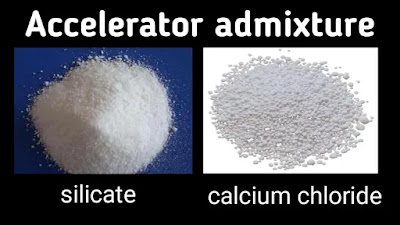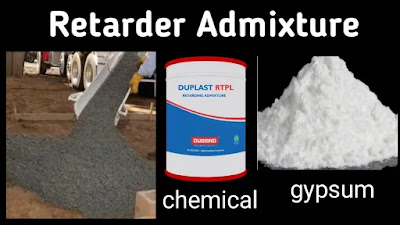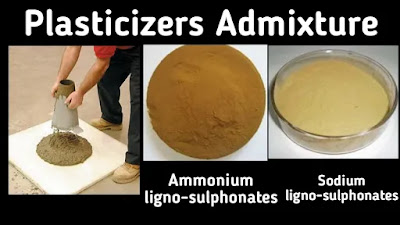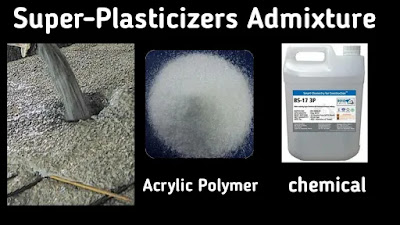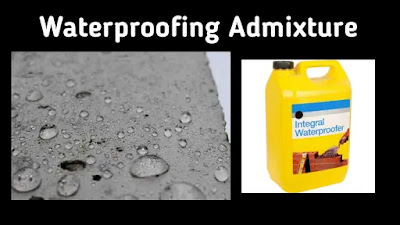We explain different types of chemical admixture used for concrete, like Accelerators, Retarders, Plasticizers, Superplasticizers, waterproofing admixture, air-entraining admixture, etc. And also explain the function of admixtures and the advantages and disadvantages of admixture.
Table of Contents
The function of Admixtures in concrete:-
- To produce non-skid wearing surfaces.
- To produce cellular concrete.
- To make the weight of concrete low per cubic meter.
- To increase the durability of concrete, i.e. its resistance to special conditions of exposure.
- To inhibit the corrosion of reinforcement in concrete.
- To increase the resistance to chemical attack.
- To reduce the heat of hydration.
- To accelerate the initial set of concrete, i.e. to the speed of the rate of development of strength at an early age.
- To retard the initial setting time i.e. to make concretely workable for a longer time for placement.
- To enhance the workability.
- To reduce the segregation in grout and concrete mixtures.
- To increase the hardness or strength of concrete by reducing the water content.
Types of Chemical Admixture Used for Concrete:
- Accelerators
- Retarders
- Plasticizers
- Super-plasticizers
- Waterproofing Admixtures
1. Accelerators:
The purpose of adding accelerators in concrete is to speed up the setting and hardening of concrete.
Advantages of using Accelerators:
- Quick removal of formwork
- Reducing curing time
- Take structure for early use
- Quickly finish surfaces
- Accelerators Used for a quick repair
- Accelerators Used for speed up construction
Main Accelerators used in Concrete
- Calcium Chloride (CaCl2)
- Soluble Carbonates
- Silicates
Calcium Chloride (CaCl2) is One of The main types of Accelerators. It is most commonly used as an Accelerator.
Adding Calcium Chloride 2% weight of the cement, in concrete. Which reduce Initial setting time 3 to 1 hours and Final Setting time 6 to 2 hours of concrete.
Getting two days Strength of concrete in One day at a temperature of 21 degrees Celsius.
Disadvantages
- If the proportion of Calcium Chloride increases to 3% then flash set of concrete is found, due To that the proportion of drying shrinkage and Creep increases in concrete.
- Calcium Chloride causes stress corrosion in Pre-stress concrete.
- Sulphate-resistance of the concrete decreases Due to Calcium Chloride Accelerator.
Other accelerators are as follows:
- Sodium Chloride (NaCl), Na2SO4,
- K2So4,
- NaOH
- KOH, Na2CO3
MC – Bauchemic (Ind.) Pvt. Ltd., Navi Mumbai manufactures some modern commercial aspirating materials, such as:
- MC – Schnell OC
- MC – Schnell SDS
- MC – Torkrethilfe
2. Retarders:
Retarders are added into the concrete for the purpose of decrease the hydration process of cement and reduce the setting time of concrete. Retarders keep the concrete in a plastic and workable condition for a long time.
Purposes of Retarders in Concrete:
- Decrease setting time of concrete
- Increases Strength of concrete By keeping Low Water/cement Ratio.
- For the purpose of concreting in Hot Region.
- For the Purpose of Grouting In Oil Well.
Main Type of Retarders Use in concrete:
- Calcium sulphate (gypsum)
- Starches
- Sugars
- Cellulose Products
- Acids or salts
Gypsum is the most widely used as a Retarder in concrete. Usually, 2 to 3% gypsum is added in concrete which fulfills the all purposes. Gypsum can also be used as a plaster of Paris. Adding more gypsum, There is also more expansion of the concrete and the setting time of concrete becomes much slower.
3. Plasticizers:
Workability is an important factor in concrete. The Workability of the concrete varies according to the situation. Required High workability at a place of construction or casting of Deep beam, Shear wall (thinner wall), Beam-Column Junction, Pumping of concrete, tremie concreting, etc.
Traditional methods like a high proportion of Fine aggregate, good grading, High cement, proportion are used to increase the workability of concrete. In some Times at a site’s water is added in concrete for the purpose of increase Workability. Which is dangerous for the durability of concrete.
Extra water in concrete just increase the porosity of concrete, due to that the defects in concrete like corrosion of reinforcement, crack in the concrete, moisture in concrete and other defects occur.
Plasticizers are also called “water-reducing admixtures“. Plasticizer Increase Workability of concrete without adding water, which is Reduce the w/c ratio of concrete. Due to that the Strength of Concrete Increase.
Main plasticizers:-
- Calcium ligno – sulphonates
- Sodium ligno – sulphonates
- Ammonium ligno – sulphonates
The amount of this type of plasticizer in concrete is 0.1% to 0.4%. Plasticizers maintain constant workability by reducing 5 to 15% of the water from concrete.
The job of the plasticizer is to improve the workability of the concrete.
4. Superplasticizers:
Japan first made Super Plasticizer in 1960 and then Germany in 1970. Superplasticizer can reduce water content by up to 30% without reducing the workability of the concrete. They are also called High Range water reducers. They are very powerful dispersing agents.
Advantages of Superplasticizers in Concrete:
- Very high workability
- Suitable for pumpable concrete, RMC
- Maintain W/C ratio 0.28 without reducing Workability and getting high strength of concrete about 100 MPa in a low water/cement ratio.
- High-performance concrete can be made using fly ash, slag, silica fume, etc.
- Prevents segregation and bleeding of concrete.
Polymers used as a base for super plasticizers:
- Sulphonated Melamine Formaldehyde Condensates (SMF)
- Sulphonated Naphthalene Formaldehyde Condensates (SKF)
- Modified Ligno – Sulphonates (MLS)
- Acrylic Polymer (AP)
- Poly Carboxylate ester (PC) etc.
5. Water Proofing Admixtures:
Leakage in the roof, bathroom, toilet, walls, kitchen, water tank, basement, etc. Is the main problem of civil engineering. There are numerous materials and methods available for waterproofing in our country. But all are fails for another reason.
The success of waterproofing depends on the quality of the material, the durability of the workmanship and the environment.
Waterproof concrete fulfill two main requirements.
- To be impermeable against water.
- Prevent water absorption.
Waterproofing Admixtures are available in a powder, paste, or liquid form. The main two types of materials
- Filing materials and other
- water repellent materials.
Pore filling materials are chemically active. It speeds up the setting time of the concrete. Examples of pore-filling materials,
- Silicate of soda
- Aluminum sulfate
- Zinc Sulphate
- Aluminum Chloride
- Calcium Chloride
Examples of Water repellent materials:
- Soda
- Pokash soaps
- Calcium Soaps
- Vegetable Oils
- Facts
- Coal tar pesidues
The following chemicals are available for waterproofing.
- Integral waterproofing compounds
- Acrylic-based polymer coatings
- Mineral-based polymer coatings
- Silicon-based water repellent material
- Waterproofing adhesives for marble, granite, tiles
- Joint sealants
WATERPROOFING CHEMICALS
1. Integral waterproofing Compounds:-
- Brand Name: CiCO, Impermo Accorproof MC-Special DM
- Remarks:- These Compounds can be used only in situations where concrete is continuously in wet or in damp condition.
2. Membrane forming waterproofing materials:-
- Brand Name: Roofex 2000 by MC – bauchemie (Ind.) Pvt. Ltd.
- Remarks:- To seal the cracks formed by drying shrinkage of concrete, cracks due to temperature variation etc. It is suitable for cracks in vertical surfaces.
3. Mineral-based Polymer coating:-
- Brand Name: Dichtament DS-flex, Brush bond, xypex
- Remarks: Slurry consists of specially processed hydraulically setting powder component and a liquid polymer component in required proportion coats of this slurry when two applied on the roof surface, water tank vertical surface of a basement, sunk portion of bathrooms etc. forms a long-lasting waterproofing coat.
4. Silicon-based water repellent materials:-
- Brand Name: NISIWA SH by MC – Bauchemie
- Remarks: Silicon-based water repellent materials forms a thin water repellent transparent film on the surface. It can be applied by spraying or brushing. It is suitable for waterproofing or unplastered surfaces of brick masonry or stone masonry.
5. Waterproofing adhesives for marble, granite, and tiles:-
- Brand Name:- Zentrival PL and Zentrival HS
- Remarks: Cement paste is not the right material for fixing the glazed tiles. There are polymer-based, ready to use water proof, tile adhesives available in the market. They offer many advantages like better bond and adhesion, strength, faster work, good waterproofing utility etc.
6. Joint sealants:-
- Brand Name:- Nitoseal 215 (1), Sikalastic, Sani seal
- Remarks: Used to seal joints in buildings, bridge roads, airfield pavements, etc. Sealants are also used to seal the gaps resulting in the installation of sanitary appliances, the gap between door frame and wall.
ALSO READ:-

I am a Professional Civil & Structural Engineer having more than 4 years of experience in Engineering, Procurement and Construction industry. Here i sharing the latest updates of EPC Projects and Construction News.


